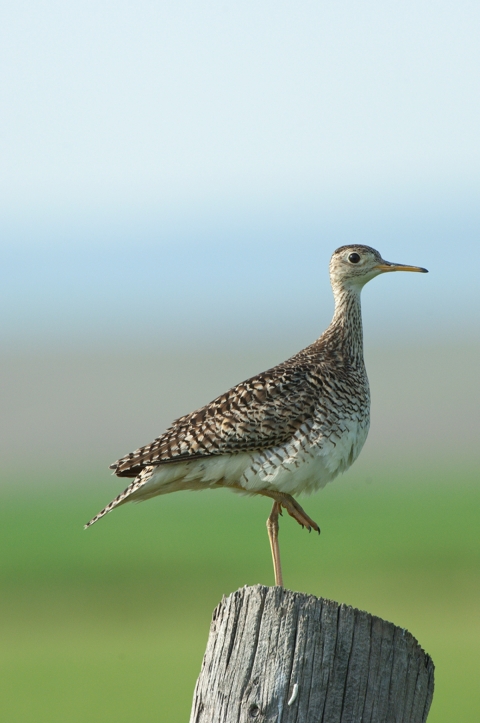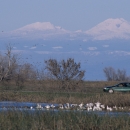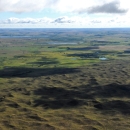About Us
The Valentine National Wildlife Refuge is located in the heart of the Sandhills in north-central Nebraska and was established by Congress in 1935 “as a breeding ground for migratory birds and other wildlife.” The Refuge is home to 270 species of birds, 59 species of mammals, and 22 species of reptiles and amphibians, and is a unique and ecologically important component of the National Wildlife Refuge System. The native grass prairie in the hills, meadows, wetlands, lakes and marshes in the valleys found here provide habitat for a diversity of wildlife.
The Sandhills formed during the last 10,000 years when strong and steady winds shaped steam-deposited sands into the dunes and valleys we see today. Periods of low rainfall likely contributed to the forming of the Sandhills by limiting the number of plants which hold the sand in place. Today, a variety of grasses and other plants shield the dunes from the force of the wind and provide a degree of stability to the dunes. These grasses include prairie sand reed, sand love, blowout, Indian, and big and little bluestem. Rainfall quickly filters through the sand to the Ogallala Aquifer, one of the largest underground water sources in the world. The abundant water source feeds the lakes, marshes, streams, and springs so important to wildlife. In many places, the water is just below the surface, providing natural underground irrigation.
Our Mission
Refuge Purposes
Each unit of the National Wildlife Refuge System is established to serve a purpose that conserves native species dependent on its lands and waters. All activities on those acres are reviewed to ensure they are compatible with Refuge purposes.
Valentine National Wildlife Refuge strives to preserve, restore, and enhance the ecological integrity of Nebraska Sandhill uplands and associated wetlands as habitat for migratory birds and other native wildlife for the benefit of present and future generations of Americans.
Our History
In 1973, a portion of the Refuge was recommended for inclusion in the National Wilderness Preservation System. The 15,937 acre proposed wilderness is located in the southwest portion of the Refuge. The proposal includes Dad’s and Mule Lakes, as well as several smaller lakes. The smaller lakes are bordered by marshes while Dad’s Lake, one of the largest natural lakes in the Sandhills, is bordered on the south by a narrow strip of trees, brush and high sandy hills. The area is very scenic with native grasses, undeveloped lakes, high choppy sand hills, and a feeling of isolation amongst the expansive prairie. Human-made structures in the wilderness consist of a few windmills, water tanks, and electric and barbed wire fences. The area of the Refuge proposed for designation as Wilderness is to be managed according to the Wilderness Act of 1964 which requires wilderness areas be managed in a natural condition for solitude or a primitive and unconfined type of recreation.
The Refuge became a Registered Natural Landmark in 1979. The National Natural Landmarks Program recognizes and encourages the conservation of sites that contain outstanding biological and geological resources. National Natural Landmarks are selected for their outstanding condition, illustrative value, rarity, diversity, and value to science and education. Sites are designated by the Secretary of the Interior. https://www.nps.gov/subjects/nnlandmarks
In 2005, Valentine National Wildlife Refuge was designated a Nebraska Important Bird Area by the National Audubon Society. The Important Bird Area program is an inventory of the key sites within a state that support significant numbers and high diversity of birds. Valentine National Wildlife Refuge was chosen for this special designation because of the high diversity of wildlife species and the large population of greater prairie chickens found there.
In 2012, Nebraska’s Center for Great Plains Studies included Valentine National Wildlife Refuge as one of the Great Plains Top 50 Ecotourism Sites. An ecotourism site is a place devoted to environmental or biodiversity conservation and provides an opportunity for the public to experience nature. Professional naturalists named sites considered to offer the best, most powerful environmental experience or places that are ecologically the most important. The Center recognizes the importance of ecotourism in helping nearby communities to thrive economically, increasing public awareness of nature, and generating funding for conservation. More information is available at www.unl.edu/plains.
Other Facilities in this Complex
Fort Niobrara National Wildlife Refuges supports an exceptional diversity of plants and wildlife representative of the northern Great Plains and geographic regions east, west, north, and south of here. In the early 1900s, President Theodore Roosevelt and private conservation organizations, such as the National Audubon Society and American Bison Society, were becoming increasingly concerned with the exploitation of wildlife and their habitats on the Great Plains and elsewhere. As a result, an Executive Order was signed on January 11, 1912, establishing Fort Niobrara as a "preserve and breeding ground for native birds." Later that year, the Refuge's purpose was expanded to include the conservation of bison and elk herds representative of those that once roamed the Great Plains.
Lacreek National Wildlife Refuges lies in the shallow Lake Creek valley on the northern edge of the Nebraska Sandhills and includes 16,410 acres of native sandhills, sub-irrigated meadows, impounded fresh water marshes, and tall and mixed grass prairie uplands. The Refuge serves as an important staging area for migrating waterfowl, sandhill cranes, shorebirds, and neotropical migrants. Providing critical wintering habitat for the high plains trumpeter swan population is a primary goal.
Crescent Lake National Wildlife Refuges lies on the southwestern edge of the Nebraska Sandhills, the largest sand dune in the Western Hemisphere. The Sandhills are characterized by rolling, vegetated hills and interdunal valleys. These habitats on the Refuge are interspersed with 21 wetland complexes—shallow lakes, marshes, seasonal wetlands, wet meadows, and a small stream. Wildlife diversity, except large ungulates and their predators, is relatively unchanged since early settlement.
North Platte National Wildlife Refuges was established in 1916 by Executive Order No. 2446 as a “preserve and breeding ground for native birds.” It is located in the Nebraska Panhandle, near Scottsbluff. It was declared a National Wildlife Refuge primarily because of fall concentrations of up to 250,000 Mallards, 11,000 Canada Geese and Bald Eagles.
John W. and Louise Seier National Wildlife Refuges is found in north-central Nebraska, as a sanctuary among the Sandhills. The Sandhills region is the largest remaining tract of mid and tall grass prairie in North America. The Seier Ranch was originally homesteaded by John and Louise Seier’s grandparents in the mid-1800's. John and Louise Seier did not have any immediate family, but did have a love of wildlife and an interest in preserving wildlife, they donated, their 2,400 acre working cattle ranch to U.S. Fish and Wildlife Service in October of 1999. Because the Refuge is so new to the System, it remains closed to the public at this time. There is no projected date for the opening of the Refuge, however, a date will be established upon the completion of a management plan.







